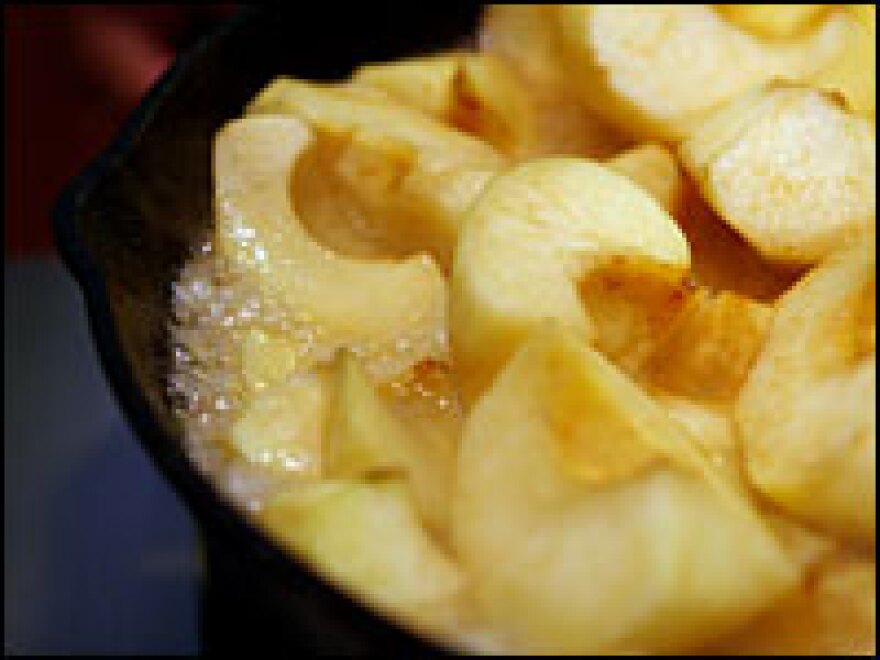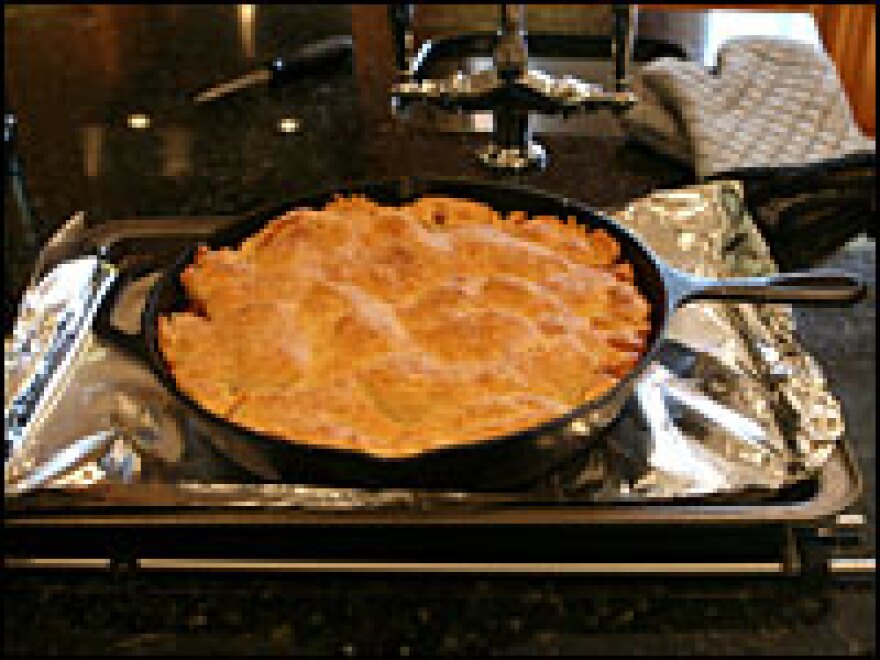


From Dorie Greenspan's Baking.
Few desserts are more storied than the tarte Tatin, which became a universal darling after the Tatin sisters, French innkeepers, famously forgot to line a pan with crust before they put in the apples and started baking. Rather than begin again, in a flash of thrift and ingenuity, they decided to put the crust on top and serve the tart upside down. For reasons I've never understood, tarte Tatin has a reputation for being a bear to bake. Not so. It's a forgiving recipe, emerging from the oven with its prettily placed apples glazed with caramel and perched on a golden pastry ring. In fact, the tart is so loosey-goosey in its construction that I can give you only a rough guess on the number of apples you'll need. You'll figure it out as you go along, and after you've made the tart once, you probably won't even need a recipe to make it again.
Makes 6 servings
1 sheet (about 8 ounces) frozen puff pastry (preferably all-butter; see Note below ) thawed, or Good for Almost Everything Pie Dough for a single crust (recipe below), chilled, or Sweet Tart Dough (recipe below), chilled
1 stick (8 tablespoons) unsalted butter
3/4 cup sugar
About 8 sweet firm apples such as Fuji, Gala or Golden Delicious, peeled, cored and quartered
GETTING READY: Center a rack in the oven and preheat the oven to 375 degrees. Choose a 9- or 10-inch ovenproof skillet — I like cast iron — or, if you've got one, a tarte Tatin pan. Line a baking sheet with parchment or a silicone mat. You'll also need a large, rimmed serving plate for the tart.
Working on a floured surface (if you are using puff pastry) or between wax paper or plastic wrap, roll the dough out until it is about 1/8 inch thick (it can be thicker, if you'd like). Using a paring knife, cut the dough into a circle that is 1 inch larger than the diameter of the pan you're using. Prick the dough all over with the tines of a fork and transfer it to the baking sheet. Cover the dough and refrigerate it while you work on the apples.
Put the skillet over medium heat and add the butter. When it melts, tilt the pan so that the sides have a thin coating of melted butter (or do this with a pastry brush). Sprinkle the sugar over the butter. Remove from the heat.
Fit a layer of apples into the skillet, putting the apples into the pan rounded side down and making concentric circles. What's important here is to pack in the apples — because they will shrink as they cook, you want to make sure they are snug in the pan. When you've got a tight single layer, cut the remaining apple quarters in half and strew them over the first layer. (You might have to cut more apples to get a fairly even layer here, or you might have apple quarters left over.) Don't worry about making this layer beautiful — no one will see it, but it will give the finished tart a little height.
Put the pan over medium heat and cook — staying close by — until the sugar turns a deep caramel color. You'll see it bubbling up the sides of the pan, but if you need a clearer view, you can gently push an apple aside. To get the color you want without burning the sugar, you may have to lower the heat after a while. Count on 15 minutes, more or less, to get the color. Transfer the skillet to the baking sheet.
Take a last look at the fruit and, if you see gaps, mounds or valleys, gently nudge the fruit into place with a wooden spoon. Remove the pastry from the fridge and center it over the fruit, loosely tucking in any overhang (it's okay if you have a double layer of dough around the edges), or not — the oven's heat will shrink the pastry to size.
Bake for 30 to 40 minutes, or until the pastry is baked through and, if you used puff pastry, puffed.
Now, here's the only tricky part: Cover the skillet with the large, rimmed serving plate and, acting quickly and confidently (and making sure you're wearing good oven mitts), turn the tart out onto the platter and remove the pan. If any of the apples have stuck to the pan — it happens to the best of us — gently lift them off the pan with an icing spatula and press them gently back onto the tart.
Let cool for at least 10 minutes before serving.
SERVING: Much as you might like to, you cannot serve the tart straight from the oven to the adoring crowd — the caramelized sugar is dangerously hot. Let the tart sit for at least 10 minutes or longer until it is only just warm, before serving, then serve it with some unsweetened crème fraîche.
STORING: While you can get the dough ready early in the day and even caramelize the apples about one hour ahead, once this tart is made, you can do right by it only by serving it within the hour.
PLAYING AROUND: While apples are the standard, the technique of caramelizing the fruit and topping it with pastry can be used with pears, mangoes (yes, mangoes — they make a great Tatin, but make sure to choose firm fruit) or quinces. The Tatin technique is also good for soft summer fruits like apricots and (peeled) peaches, but be gentle in that case: It's best to cook the butter and sugar in the skillet without the fruit. When the caramel is the color you want, remove the pan from the heat and cool the mixture. Arrange the fruit in the pan, cover it with the pastry and bake.
Note: Pepperidge Farm puff pastry sheets are available in every supermarket across the country. However, I can't encourage you enough to search out an all-butter puff pastry at a local specialty store. If the store doesn't carry frozen all-butter puff pastry, perhaps it will order it for you. The pastry I buy — which is so good that I stopped making puff pastry at home — is made by Dufour Pastry.
Copyright 2023 NPR. To see more, visit https://www.npr.org. 9(MDM3NjYwMjA5MDE1MjA1MzQ1NDk1N2ZmZQ004))

